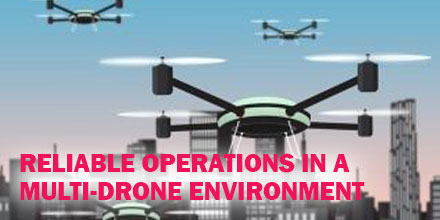18Sep
Reliable Operation in a Multi-Drone Environment
 From their military origins a few decades ago -- carrying sophisticated systems and running remote, cross-boarder missions -- drones are now commercial and industrial platforms.
Today, drones play a significant role in the next generation of automated and autonomous vehicles. The vision of multiple drones filling in the public sky, running various missions smoothly is slowly becoming a reality.
From their military origins a few decades ago -- carrying sophisticated systems and running remote, cross-boarder missions -- drones are now commercial and industrial platforms.
Today, drones play a significant role in the next generation of automated and autonomous vehicles. The vision of multiple drones filling in the public sky, running various missions smoothly is slowly becoming a reality.
Operational Reality
In fact, drone operation in such an environment is so challenging that stable and reliable communication is crucial. The communication infrastructure must provide carrier-class availability, ensuring control and telemetry signals are available in real-time. And, that critical data flows between the drone and operation control centers. In addition, automated airspace management systems must guarantee full coordination between different vehicles using the same air space. These systems are called UTM (Unmanned Traffic Management) systems. The dynamic nature of the drone’s operation should have a ‘network’ planning perspective rather than a ‘link’ based perspective. All drones utilize RF (radio frequencies) to communicate with their respective ground stations and, eventually, with each other. As frequency bands and channels are scarce and are also used by other platforms such as Wi-Fi systems, interference is the major obstacle for reliable communication. The more drones in a given area, the more fragile each link becomes due to other system interference. This poses a significant challenge for inter-operability of multi-drones in a given environment.Communication Challenges in a Multi-Drone Environment
For example, the delivery market is one of the most complex drone applications. It requires running multiple drones in parallel, by different service providers. Some of the related communication challenges include:- Near-End Interference – generated by other drones launched from the same or nearby network operating centers.
- Far-End Interference – generated closer to the landing area, from Home Routers such as WIFI or other systems operating nearby such as agriculture drone systems.
- In-Flight interference – from other drones flying nearby, Radio Control (RC) recreational vehicles.
- BVLOS operation – flying in an urban area can generate signal loss and fading due to high-rise buildings and other obstacles.
- Terrain Obstacles – rural operation may introduce signal fading due to Fresnel zone blocking by a hilly terrain.
- Interoperability with mobile networks – utilizing dual combined communication can increase reliability but must include a smooth switch-over mechanism when the public network is congested or out of reach.

